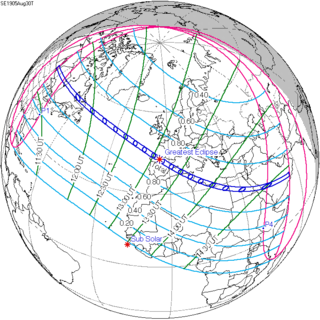Solar eclipse of August 30, 1905
| Solar eclipse of August 30, 1905 | |
|---|---|
| Type of eclipse | |
| Nature | Total |
| Gamma | 0.5708 |
| Magnitude | 1.0477 |
| Maximum eclipse | |
| Duration | 226 sec (3 m 46 s) |
| Coordinates | 42°30′N 4°18′W / 42.5°N 4.3°W |
| Max. width of band | 192 km (119 mi) |
| Times (UTC) | |
| Greatest eclipse | 13:07:26 |
| References | |
| Saros | 143 (17 of 72) |
| Catalog # (SE5000) | 9293 |
A total solar eclipse occurred on August 30, 1905. A solar eclipse occurs when the Moon passes between Earth and the Sun, thereby totally or partly obscuring the image of the Sun for a viewer on Earth. A total solar eclipse occurs when the Moon's apparent diameter is larger than the Sun's, blocking all direct sunlight, turning day into darkness. Totality occurs in a narrow path across Earth's surface, with the partial solar eclipse visible over a surrounding region thousands of kilometres wide.
Scientists came from all over the world to Alcalà de Xivert in Spain to watch the eclipse on August 30, 1905.
Each member in a semester series of solar eclipses repeats approximately every 177 days and 4 hours (a semester) at alternating nodes of the Moon's orbit.
It is a part of Saros cycle 143, repeating every 18 years, 11 days, containing 72 events. The series started with partial solar eclipse on March 7, 1617 and total event from June 24, 1797 through October 24, 1995. It has hybrid eclipses from November 3, 2013 through December 6, 2067, and annular eclipses from December 16, 2085 through September 16, 2536. The series ends at member 72 as a partial eclipse on April 23, 2873. The longest duration of totality was 3 minutes, 50 seconds on August 19, 1887.
...
Wikipedia

